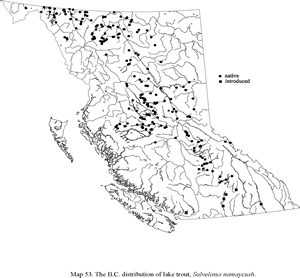Dorsal spines (total): 4 - 5; Dorsal soft rays (total): 8 - 10; Anal spines: 4 - 5; Anal soft rays: 8 - 10; Vertebrae: 61 - 69. Distinguished by its color, white or yellowish spots on a dark green to grayish background, its deeply forked tail and its numerous pyloric caeca. Lateral line slightly curved anteriorly; pelvic fins with small axillary process (Ref. 27547). Body typically trout-like, elongate, somewhat rounded. Head stout, broad dorsally; mouth large, terminal, snout usually protruding slightly beyond lower jaw when mouth is closed. Back and sides usually dark green liberally sprinkled with whitish to yellowish (never pink or red) spots; overall color varies from light green to gray, brown, dark green or nearly black; belly white; pale spots present on dorsal, adipose and caudal fins and usually on base of anal; sometimes orange-red on paired fins, especially in northern populations; anterior edge of paired and anal fins sometimes with a white border. At spawning time, males develop a dark lateral stripe and become paler on the back (Ref. 27547). Caudal fin with 19 rays (Ref. 2196).
Source: FishBase. Page, L.M. and B.M. Burr 1991 A field guide to freshwater fishes of North America north of Mexico. Houghton Mifflin Company, Boston. 432 p
